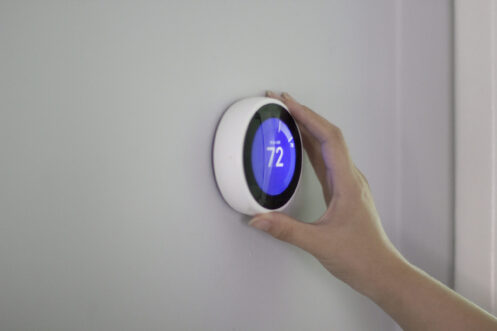August 15, 2023

What Is the Recommended Thermostat Setting for Optimal Comfort?
The climate of the area you live in plays a significant role in determining the ideal indoor temperature setting. Regions with extreme temperatures may require more cooling or heating to maintain a comfortable environment. In such cases, improving insulation, sealing air leaks, and using energy-efficient windows can enhance indoor comfort and reduce the strain on heating and cooling systems.
Apart from external factors, specific considerations can also influence your ideal indoor temperature setting. The age and health conditions of household members play a role; infants, elderly individuals, or those with specific medical needs may require a slightly different temperature setting to ensure their comfort and well-being. Read on to learn how you can create a comfortable living space with the right thermostat setting while promoting responsible energy consumption.
Finding the Right Temperature Setting for Your Home
Personal Comfort Preferences
Age, health conditions, and individual preferences can influence the ideal indoor temperature setting. Some people prefer a warmer environment whereas others prefer it cooler. It’s essential to find a balance that suits the majority of occupants while ensuring the overall comfort of your household.
Seasonal Considerations
During winter, setting the thermostat to a lower temperature when you’re away or sleeping can help save on energy costs. In contrast, raising the thermostat a few degrees during the summer can significantly reduce cooling expenses. Adapting your thermostat settings based on the season can help create a comfortable living environment while optimizing energy efficiency.
Energy Efficiency and Cost Savings
The U.S. Department of Energy recommends setting your thermostat to around 68 degrees Fahrenheit during the winter and 78 degrees Fahrenheit during the summer for the best balance between comfort and energy savings. However, these numbers can be adjusted to suit your needs and climate conditions.
Zoning and Room Usage
Consider adjusting the thermostat settings if your home has multiple zones or rooms with varying usage patterns. For example, you can lower the temperature in less-used rooms or in unoccupied areas to save energy while keeping the main living spaces comfortable.
Programmable and Smart Thermostats
Advanced thermostats allow you to create customized schedules based on your daily routines and can even learn your preferences over time. With features like remote access and occupancy sensors, smart thermostats can further optimize energy use while maximizing comfort.
Balancing Energy Efficiency and Health
Extremely low temperatures during winter or excessive heat during summer can lead to respiratory issues or heat-related illnesses. As a result, when configuring temperature settings in your thermostat, finding a balance between energy efficiency and maintaining a healthy indoor environment is paramount to keeping you and your family healthy throughout the year’s changing seasons.
Adjusting Thermostat Settings When You’re Away
During an extended absence from your home, it’s recommended to set your thermostat to a higher temperature in the summer or a lower temperature in the winter, depending on the climate in your area. Setting the thermostat a few degrees higher than your usual comfort level for hot summer months can yield substantial energy savings. Similarly, setting the thermostat a few degrees lower can significantly reduce heating costs during cold winters.
Programmable thermostats and smart home systems have revolutionized how we manage thermostat settings when away. These advanced systems allow homeowners to create custom schedules, enabling the thermostat to automatically adjust based on your daily routines. For example, you can program the thermostat to switch off when you leave for work and resume your preferred temperature setting a few minutes before you return home. This intelligent feature not only saves energy but also ensures you come back to a comfortable indoor environment.
Smart Thermostats and Their Benefits
Enhanced Energy Efficiency
Smart thermostats use advanced algorithms and machine learning to understand your heating and cooling patterns, adjusting the temperature settings based on your preferences and daily routines. By learning when to lower or raise the temperature, smart thermostats can significantly reduce energy consumption, leading to cost savings on utility bills and a reduced carbon footprint.
Remote Access and Control
With smart thermostats, you can control your indoor temperature conditions from anywhere using your smartphone or other internet-connected devices. Whether at work, on vacation, or just sitting in the living room, you can easily adjust the thermostat settings. This remote access ensures that you always return to a cozy home after being away.
Learning Capabilities
Modern smart thermostats have learning capabilities that allow them to adapt to your preferences and schedule over time. They can recognize patterns of temperature adjustments and make automatic changes accordingly. For example, if you prefer a cooler bedroom at night, the thermostat will take this preference into account and adjust the temperature levels in your room accordingly.
Integration With Smart Home Systems
Smart thermostats can seamlessly integrate with other smart home devices and systems, creating a more comprehensive and interconnected home automation experience. They can communicate with smart lighting, occupancy sensors, and weather forecasting systems to optimize energy use and indoor comfort levels. For instance, the thermostat can adjust the temperature based on whether the home is occupied or if there is a sudden temperature drop due to weather changes.
Energy Usage Reports and Insights
Smart thermostats often provide detailed energy usage reports and insights. These reports clearly show the amount of energy that your heating and cooling systems consume and the specific times when energy consumption is extremely high, helping you identify potential areas or periods you can cut down on energy use. This data will empower you to make informed decisions about energy consumption and work towards a more sustainable lifestyle.
Smart Assistant Compatibility
Many smart thermostats are compatible with popular voice-activated smart assistants like Amazon Alexa, Google Assistant, or Siri. This allows you to control the thermostat using voice commands, making temperature adjustments even more effortless and hands-free.
Geofencing Technology
Geofencing is a feature that utilizes your smartphone’s location to detect when you’re approaching home or leaving. By setting up a geofence, the thermostat can automatically adjust the temperature levels based on your proximity to the house, ensuring optimal comfort as soon as you step inside. At Scott-Lee Heating Company, our experts can assist you in identifying suitable geofencing products for your home’s design and exterior.
Thermostat Maintenance and Calibration
Regular Cleaning
Dust accumulation can lead to inaccurate temperature readings, causing your HVAC system to run longer than necessary. This consequently leads to increased energy usage and high utility bills. You can trust our technicians to safely and effectively clean your thermostat. Typically, we use a soft, dry cloth or compressed air to clean the internal components carefully. Our professionals are always cautious not to damage any delicate parts during cleaning.
Checking for Accuracy
It’s essential to check the accuracy of your thermostat’s temperature readings from time to time. You can accomplish this by placing a digital thermometer near your thermostat to compare the readings. If there’s a significant discrepancy between the thermostat’s reading and the thermometer’s reading, your thermostat may require recalibration.
Recalibration
Calibrating a thermostat involves adjusting its internal settings to ensure it provides accurate temperature readings. While the process may vary depending on the type and model of the thermostat, most modern thermostats have a calibration feature within their settings. However, hiring a professional HVAC technician to calibrate your thermostat is the best course of action to avoid damage to your thermostat and its components and ensure accurate calibration.
Location Matters
Avoid placing your thermostat in direct sunlight, near drafty areas, or heat-emitting appliances. These factors can contribute to false readings and lead to inefficient temperature control. Ideally, position your thermostat on an interior wall in a central location, away from any potential sources of temperature fluctuations.
Battery Replacement
If your thermostat is battery operated, regular battery replacement is essential to ensure its proper functioning. Low batteries can cause your thermostat to lose its settings or provide inaccurate readings. Make it a habit to check the battery status, and replace it when necessary. You can also upgrade to a thermostat with a wired power source.
Hire a Professional
When it comes to expert HVAC services and solutions, Scott-Lee Heating Company has proven to be a reliable choice in the St. Louis area. We provide valuable insights on setting the right thermostat temperature for your home and offer a comprehensive range of other IAQ services to maximize your indoor comfort throughout the year. From professional heating and cooling installations and repairs to air quality assessments and duct cleaning, our team of skilled technicians is dedicated to enhancing your indoor environment. With our commitment to excellence and customer satisfaction, you can count on us to create a comfortable and efficient living space for you and your family. Contact Scott-Lee Heating Company today for more information on our services!
